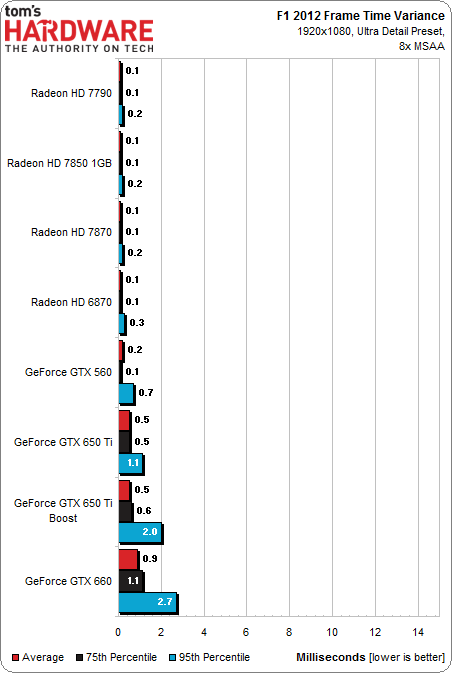GeForce GTX 650 Ti Boost Review: A Budget-Oriented GK106-Based Boss
Features
By
Don Woligroski
published
Add us as a preferred source on Google
Results: F1 2012
On average, Nvidia's GeForce GTX 650 Ti Boost trails the Radeon HD 7850 just slightly in this game. Perhaps that's to be expected, though, since F1 tends to favor AMD's cards.
Nevertheless, only the GeForce GTX 650 Ti falls below 40 FPS, and just barely. All of these boards deliver otherwise-smooth performance with 8x MSAA enabled.
The variance observed between successive frames tends to be extremely low in F1 2012, which is good.
Stay On the Cutting Edge: Get the Tom's Hardware Newsletter
Get Tom's Hardware's best news and in-depth reviews, straight to your inbox.
Contributor
Don Woligroski was a former senior hardware editor for Tom's Hardware. He has covered a wide range of PC hardware topics, including CPUs, GPUs, system building, and emerging technologies.
144 Comments
Comment from the forums
-
Souv_90 anandtech review is out for 650 ti boost...just faster than 7790 and slower than 7850 in every games tested only except bf3 and ShogunReply
http://www.anandtech.com/show/6838/nvidia-geforce-gtx-650-ti-boost-review-
(wonder why tom's review is swaying more in favour of kepler everytime I see) -
EzioAs This card pricing seems a little too good that it kinda makes me regret getting the GTX660 just a while ago. Damn it, I hate the Kepler series and their pricing :/Reply
Although I can't say the same about the power consumption and some part in me actually hoped and expected the card would come with a game bundle. -
Memnarchon Souv_90anandtech review is out for 650 ti boost...just faster than 7790 and slower than 7850 in every games tested only except bf3 and Shogunhttp://www.anandtech.com/show/6838 st-review-(wonder why tom's review is swaying more in favour of kepler everytime I see)Techpowerup said also that 650ti boost is faster than 7850.Reply
edit: hardwarecanucks / PCPerspective. A lot of sites agree with Tom's, 7850 and 650ti boost are about the same in performance.
But the point is that is similar to 7850 while its cheaper. Now that's what I wanted to see when I was saying we need better performance for $$$. Now lets see AMD dropping its prices too so we can have a sweat war between them that profits our wallet :D. -
tomfreak It looks to me form the chart except the 7900. AMD GCN is are actually far more efficient here. Better compute + better performance/watt. So Nvidia taunting about their 'most efficient GPU' seems got defeated again. I wonder what if AMD make 7900 a 1.5x of 7800.Reply
I still do not like the idea of Odd memory configuration. 1GB/2GB @ 192bit. The last 512MB from 2GB model is only getting 64bit memory bandwidth. Why cant they offer a a proper 1.5GB version @ middle price $159?
Tomshardware fail to bench 2GB 7850. I like to see that vs 2GB 650Ti Boost. -
Henrik Olsson from reviews around the web the GTX 650 ti boost is trading blows with the 7850 very well. i just gotta say it took nvidia awhile to get back into the game after AMD lowerd the pricing of there cards. good to see some competion again insted of just going "get the AMD card they are cheaper"Reply -
de5_Roy darn it. i was enjoying reading the review considering i've been waiting to se how this card performs ever since i heard of it. 192bit interface with a cut-down gk106 under $170 and sli - makes gtx 650ti irrelevant and puts a good deal of hurt on the 128bit 7790 in terms of config. i doubt gtx650tiboost can outperform a 7790 in compute tasks but this is a gaming gfx card above all. this seems like a good proposition for budget 1080p gaming, so far.Reply
now, if amd brings back 7850 1gb, it'd be awesome (i don't buy the 'lack of gddr5 chips' excuse for a second).
will there be gtx650tiboost sli performance analysis vs 7790 cfx and 7850 1gb cfx? hopefully nvidia has good drivers available because the sub $200 gfx card price war just got heated up.
edit: imho nvidia is late to the sub $200 gfx card price war. this card shoulda come out instead of gtx 650ti (128bit). amd should be updating with new gcn cards soon while kepler 2.0 seems nowhere in sight. better late(!) than never, i guess..


